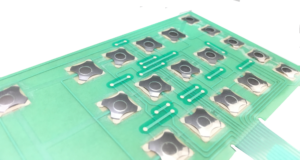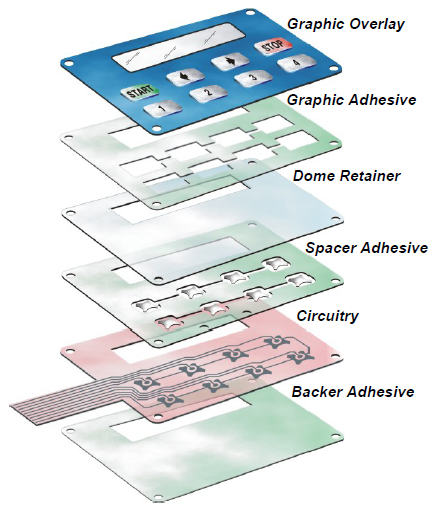How Membrane Switches Contribute to the Success of Connected Appliances
Membrane Layer Change Innovation: The Trick to Trustworthy and Cost-efficient User Interfaces
Membrane switch technology has actually become a critical element in the design of individual interfaces, offering both integrity and cost-effectiveness across a varied variety of applications. Its robust construction makes certain resistance to environmental difficulties, while the versatility in design enables for customized options that meet particular industry demands. As we explore the multifaceted advantages of membrane layer switches, their possibility for development increases questions concerning future applications and developing fads. What does the next phase hold for this technology in an increasingly digital landscape?
Recognizing Membrane Layer Switch Over Innovation
Membrane button innovation is an extensively used interface remedy in various electronic tools, supplying a smooth mix of functionality and layout. This modern technology incorporates several layers of products, normally being composed of a visuals overlay, spacer layer, and a circuit layer. The visuals overlay displays the interface elements, while the spacer layer separates the circuit layer from the overlay up until an individual activates a button.
When stress is used to the overlay, the circuit layer finishes the electric circuit, sending out a signal to the tool. This device permits for numerous setups, consisting of responsive feedback and backlighting options, enhancing individual interaction. Membrane switches are generally manufactured using sturdy products such as polyester or polycarbonate, making certain long life and resistance to environmental factors like moisture and dust.
The versatility of membrane changes enables their application in diverse markets, including medical devices, consumer electronic devices, and commercial controls. Their portable style permits for integration into space-constrained environments, giving a reliable interface without endangering aesthetic appeal. Comprehending the complexities of membrane layer button modern technology is crucial for producers and designers seeking to develop dependable and reliable human-machine user interfaces.
Trick Advantages of Membrane Switches
While various user interface options exist, membrane changes offer distinct benefits that make them a favored option in countless applications. One of the main benefits is their durability; membrane layer buttons are developed to withstand rough ecological conditions, consisting of wetness, dust, and temperature changes, ensuring lasting efficiency. This durability significantly minimizes the need for constant replacements, thereby decreasing overall maintenance expenses.

Moreover, membrane buttons are lightweight and compact, making them suitable for applications where room is restricted. Their low-profile style adds to a streamlined look without endangering functionality.
Cost-effectiveness is also a significant benefit, as the production process for membrane layer changes tends to be cheaper compared to traditional mechanical switches. This affordability, integrated with their reliability and ease of installation, placements membrane layer switches over as a useful remedy for a wide variety of industries looking for effective and efficient customer interfaces.
Applications Across Various Industries
How do membrane buttons adapt to the varied needs of various sectors? Membrane layer switch technology is increasingly recognized for its convenience, making it ideal for a vast array of applications across numerous markets. In the clinical area, membrane switches are utilized in diagnostic equipment and person monitoring gadgets, where their durability and ease of cleansing are important for maintaining health standards. The auto sector utilizes these buttons in control panels and control board, supplying a structured visual while guaranteeing user-friendly operation.
In consumer electronics, membrane buttons offer a small service for remote controls and home devices, boosting customer experience with instinctive style. Furthermore, the commercial industry leverages membrane buttons for equipment control panels, taking advantage of their resistance to severe settings, such as dampness and dirt.
Army and aerospace applications also make use of membrane layer buttons for their integrity and capability to withstand extreme conditions, making certain functional effectiveness in important scenarios. The food and drink market embraces these buttons for automated systems, where hygiene and simplicity of procedure are vital (membrane switch). Eventually, membrane layer Related Site buttons are customized to fulfill the unique demands of each industry, showing their important function in contemporary innovation user interfaces
Layout and Modification Alternatives

In the world of membrane switch technology, design and customization alternatives play an essential function in enhancing performance and individual interaction. These buttons can be tailored to fulfill details functional demands and aesthetic choices, making them flexible components in numerous applications.
One of the primary customization choices is the layout of the button itself, which can be designed to fit distinct user interfaces and ergonomic factors over here to consider. By adjusting the form, size, and setup of switches, suppliers can produce intuitive styles that help with convenience of use. Additionally, the unification of different shades and graphic overlays enables branding and improved presence, guaranteeing that individuals can rapidly recognize functions.
In addition, membrane buttons can be crafted with numerous tactile responses systems, such as increased buttons or distinct clicks, to improve the customer experience. Various materials can also be selected for toughness and environmental resistance, addressing variables such as wetness, temperature level changes, and chemical direct exposure.
Inevitably, the comprehensive layout and customization alternatives available in membrane layer button innovation encourage companies to develop tailored solutions that not just fulfill practical demands yet also align with their branding and functional needs.

Future Patterns in Membrane Layer Buttons
As membrane layer button technology continues to progress, future patterns are significantly concentrated on improving user experience and integrating sophisticated capabilities. One substantial pattern is the assimilation of touch-sensitive and capacitive technologies into traditional membrane switches. This advancement permits for even websites more instinctive user interfaces, offering responsive comments while maintaining a streamlined design.
Another arising trend is making use of ecologically friendly products, driven by the expanding demand for sustainable manufacturing methods. Suppliers are looking for to decrease their carbon impact by using recyclable substrates and low-impact inks, lining up with international sustainability goals.
Additionally, the increase of the Internet of Things (IoT) is triggering the incorporation of wise features right into membrane layer buttons. Boosted connection choices will enable gadgets to communicate with each other, enabling seamless assimilation right into wider systems.
In addition, developments in printing technologies, such as electronic printing, are permitting greater layout versatility and customization. This makes it possible for manufacturers to generate complex styles and lively colors cost-effectively.

Conclusion
To conclude, membrane switch innovation stands for a crucial innovation in interface layout, offering considerable benefits in sturdiness, customization, and cost-effectiveness. Its extensive applicability throughout varied sectors highlights its relevance in contemporary innovation. As advancements remain to emerge, especially in touch-sensitive user interfaces and sustainable materials, the potential for membrane switches over to improve individual experience and capability remains appealing. Proceeded expedition of this technology will likely produce additionally improvements and widen its extent in future applications.